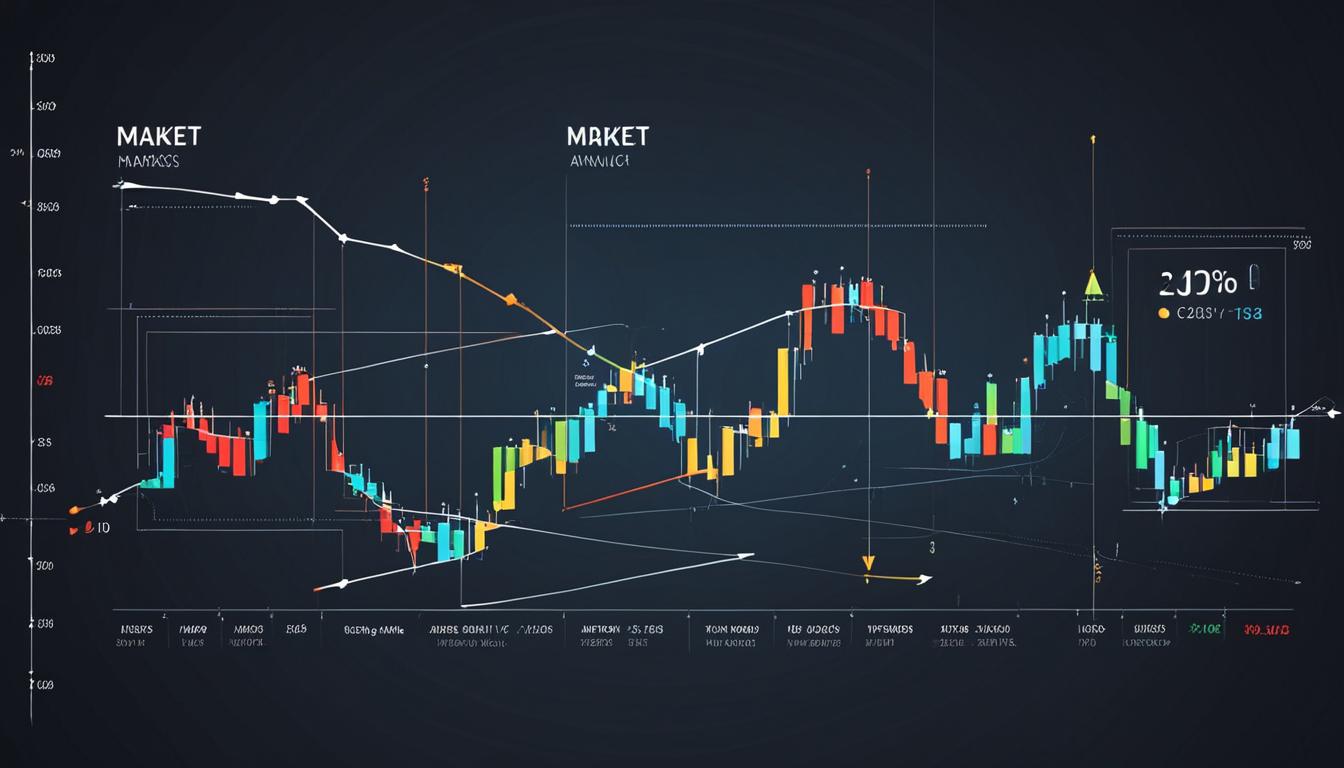Understanding the ebbs and flows of market trends is crucial for any investor or trader seeking to navigate the complex world of securities. The patterns of lower highs and higher lows stand out as significant indicators, providing insight into the shifting psychology of market participants. These oscillations form the foundation of technical analysis and are essential for crafting informed trading strategies.
Recognizing these patterns not only simplifies the visual complexity of price movements but also lends a strategic advantage by signifying potential changes in market sentiment. Whether dealing with stocks, indices, or commodities, the judicious application of this knowledge can be the difference between a reactive approach and a proactive one, fostering better entry and exit decisions in the trading arena.
Deciphering the Language of Market Trends
The fluid dance of numbers and charts that stock traders scrutinize daily is more than just a cacophony of random movement. At its core, the financial market is abuzz with a language all its own, driven by raw data and nuanced through the perceptions and reactions of investors worldwide. The layers of complexity in understanding market trends can be unwrapped by dissecting the fundamental signals within price charts—specifically, the highs and lows that narrate the ever-changing market sentiment.
The Role of Highs and Lows in Trend Analysis
In the pursuit of mastering trend analysis, both new and seasoned investors pay heed to the significance of highs and lows plotted on the graph. These points are not mere static figures; they echo the triumphs of bulls and the retreats of bears in the financial jungles. A ‘higher high’, repeated through a series of trading sessions, foretells confidence and a robust uptrend, propelling trading strategies to capitalize on growing optimism. The counterpoint, a ‘lower high’, can signal a waning thrust and prelude to downtrend possibilities, urging caution and reevaluation of positions.
Patterns that Define Market Sentiment
Scrutinizing the patterns that securities sketch over time yields significant insight into the collective psyche of the marketplace. Higher highs are seen as the footprints of a bullish sentiment, with investors driving prices upward as confidence permeates the trading floors. Conversely, the occurrence of lower lows instills a sense of urgency as a bearish outlook takes hold, potentially heralding a sell-off spree. For the analytical mind, these patterns are not merely fluctuations but veritable trading signals, opportunities to engage with the market’s ebb and flow strategically.
Visualizing Market Direction Through Price Movements
One need only glance at the charts to perceive the rhythm of market sentiment. Amongst the jumbled maze of line and candlestick charts, a pattern of ascending peaks signals an aggressive market climbing the ladder of valuation. Each peak, reaching slightly higher, reassures the continuation of an uptrend. In stark contrast, the story of descending troughs speaks of uncertainty and an impending sense of correction or even a downtrend on the horizon. These visual cues, once deciphered, arm traders with the foresight needed to anticipate the next significant trading signal.
Ultimately, the artistry of interpreting trend analysis illuminates the deeper narrative stitched in the fabric of market movements. It’s the tension between fear and greed, supply and demand, and the innumerable factors that culminate in the formation of higher highs and lower lows—each a stanza in the richly complex poem of market sentiment.
Lower Highs and Higher Lows: Indicators of Market Sentiment Shifts
In the sphere of financial trading, a shrewd observer can detect sentiment shifts through the key patterns of lower highs and higher lows. These patterns are the sentinels of change, often preceding fresh market trends and providing vital clues for developing trading strategies. Through careful technical analysis, a proficient trader unlocks the ability to foresee potential reversals and align with the market’s momentum.
The crafting of trading strategies that incorporate these tell-tale signs enables traders to synchronize with the market’s cadence. Recognizing a lower high allows for predictive measures against a downturn, as it reflects faltering buyer interest. Conversely, spotting a higher low might indicate the waning strength of a selling trend, potentially giving way to bullish undertakings. In essence, each of these patterns represents a meaningful dialogue betwixt the market and the trader, narrating the ebb and flow of collective trader psychology.
- Lower Highs: Signal ascending caution amongst buyers, possibly heralding a bearish future.
- Higher Lows: Suggest an attenuation of bearish conviction, potentially ushering in a bullish phase.
The table below delineates a relationship between these crucial patterns and their respective market sentiment implications:
| Pattern | Implication | Trading Strategy Alignment |
|---|---|---|
| Lower Highs | Bearish Sentiment Increase | Consider short positions or exit long positions |
| Higher Lows | Bullish Sentiment Increase | Explore long positions or tighten stop-losses for shorts |
In economics as in nature, adaptation is key to survival. Thus, a trader adept at interpreting these subtle yet profound signals can elegantly navigate the tempest of market fluctuation. This analytical prowess, forged through the fires of experience and knowledge, is the traders’ bastion against the caprice of trading environments.
Technical Indicators as Tools for Sharpening Trading Acumen
For traders eager to refine their trading strategies, the application of technical indicators is non-negotiable. With various charting tools at their disposal, recognizing patterns like higher highs and lower lows becomes second nature, giving traders the leverage to perform astute market analysis. Let’s delve into the intricacies of using these tools to enhance trading acumen and execute effective trades.
Step-by-Step Guide to Charting Higher Highs and Lower Lows
The process of charting involves meticulous analysis and a clear understanding of market trends. To begin charting these pivotal patterns:
- Select a timeframe: Depending on your trading style, choose from minute-by-minute charts for day trading or weekly charts for long-term analysis.
- Identify price points: Locate the pivotal peaks (highs) and troughs (lows) that signify potential trend shifts.
- Draw trendlines: These visual aids connect consecutive highs or lows, helping to clarify the trend direction.
Mastering this skill enriches a trader’s technical proficiency and influences accurate market forecasts.
Combining Other Technical Indicators for Enhanced Insight
While charting provides a foundational understanding of market movements, integrating additional technical indicators fosters a comprehensive analysis:
- Moving Averages: Useful in smoothing out price action and determining the momentum direction.
- MACD (Moving Average Convergence Divergence): Highlights the velocity of price changes, enabling traders to spot trend reversals promptly.
- RSI (Relative Strength Index): Measures the magnitude of recent price changes, assisting in identifying overbought or oversold conditions.
When synthesized, these tools offer a more nuanced view of the markets, empowering traders to make informed decisions.
Software and Tools for Efficient Pattern Recognition
Advanced trading software and tools have simplified the task of pattern recognition:
Today’s top charting platforms provide myriad features for dynamic technical analysis:
- Automated pattern recognition: Quick detection of classical patterns such as head and shoulders, wedges, and flags.
- Signal alerts: Notifications for preset criteria, such as when a stock hits a high or low.
- Backtesting capabilities: To verify the efficacy of certain patterns and strategies using historical data.
These functionalities are instrumental for continually refining a trader’s pattern recognition capability and ultimately, trading performance.
Overall, the integration of technical indicators with sophisticated charting tools serves as the bedrock for developing keen pattern recognition, essential for any trader’s skill set. It is continuous learning and practice, enhanced by these technological advancements, that sharpen traders’ abilities to navigate complex markets and potentially lead to success.
Strategizing with Market Dynamics: Entry, Exit, and Risk Management
Mastering the financial markets requires a combination of keen observation of market dynamics and the implementation of solid entry strategies, risk management measures, and exit plans. The behavioral patterns of lower highs and higher lows reveal critical junctures where traders can pivot their strategies for optimal performance.
Determining Optimal Entry Strategies Through Trend Analysis
Entry strategies are the cornerstone of successful trading, and market dynamics provide a window into when to enter positions. A higher low spotted in an upward trend signifies a strong potential entry point for a long position, while a lower high observed during a downtrend may present an opportunity to initiate a short position. By adapting to these subtle market cues, traders can enhance their entry strategy effectiveness.
Setting Stop-Loss and Take-Profit Points in Line with Market Patterns
Incorporating stop-loss and take-profit orders is essential for risk management, preventing substantial losses, and securing profits. Aligning these markers with market patterns such as lower highs and higher lows not only optimizes trade outcomes but also instills discipline in the trading process. Decisions become systematic rather than emotional, bolstering traders’ resilience against market volatility.
Advanced Strategies Using Highs and Lows
For those looking to employ more sophisticated techniques, integrating advanced strategies such as breakouts or reversals can be greatly rewarding. Utilizing tools like Fibonacci retracements helps identify potential pivot points, further refining trade timing and execution.
| Trend | Optimal Entry | Stop-Loss Placement | Take-Profit Placement |
|---|---|---|---|
| Uptrend | After a higher low | Below the recent higher low | Before the next projected higher high |
| Downtrend | After a lower high | Above the recent lower high | Before the next projected lower low |
By diligently applying these entry and exit principles, traders harness the power of market dynamics to navigate through the marketplace’s ebbs and flows. While risk is an inherent part of trading, a strategic approach informed by market behavior can lead to consistent and measured success.
Conclusion
In the realm of financial trading, a keen ability in market analysis can be the linchpin for enduring success. The patterns of lower highs and higher lows serve more than mere annotations on a trader’s chart; they are a language in themselves, speaking volumes about trend identification and impending market shifts. For the astute trader, these are not just patterns but powerful tools that, when harnessed effectively, can signal when to act and when to exercise caution.
Through the diligent application of these cornerstone concepts, the potential for enhanced trading performance becomes palpable. As market participants harness these trends to develop strategies, they pave the way to a more controlled trading environment. The interplay of skilled analysis, risk management, and strategic timing converges to craft a comprehensive trading approach that seeks to optimize gains while mitigating financial exposure.
However, with the advantage that these analytical tools provide comes the sobering reminder of the complexities intrinsic to financial markets. Acknowledging the risks inherent in trading, the tactical trader employs thorough, disciplined analysis before allowing these patterns to guide investment decisions. It’s this balance of insight and caution that can lead to sustainable trading ventures in the dynamic tides of the global markets.






